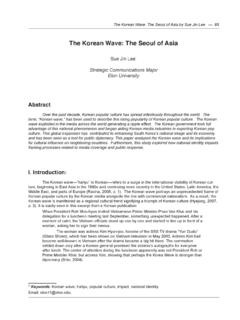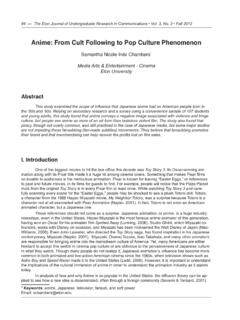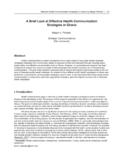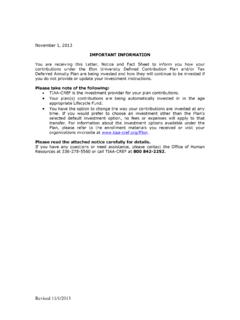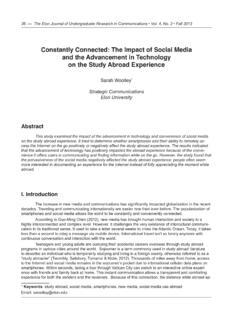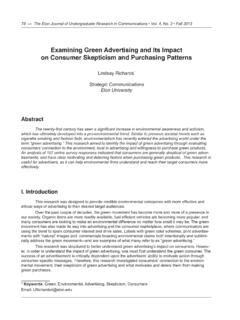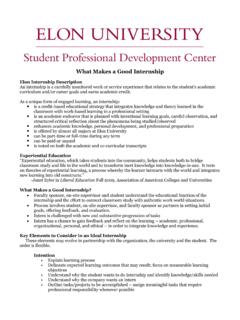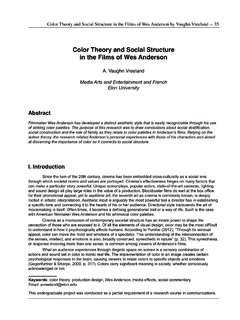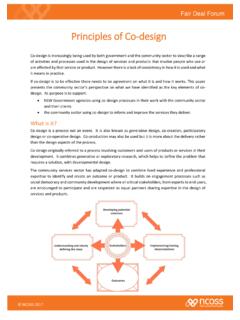Transcription of How YouTube Developed into a Successful Platform for User ...
1 52 Elon Journal of Undergraduate Research in Communications, Vol. 7, No. 1 Spring 2016 Keywords: YouTube , user-generated content, personal branding, content creators, viewers Email: This undergraduate project was conducted as a partial requirement of a research course in communications. How YouTube Developed into a Successful Platform for User-Generated Content Margaret Holland Cinema and Television Arts Elon UniversityAbstractSince its development, YouTube , the world s third most popular online destination, has transformed from a video-sharing site into a job opportunity for content creators in both new and mainstream media.
2 Based on content analysis, the study examined how three prominent YouTubers have created a Successful personal brand. Analysis revealed the common characteristics that these online celebrities shared, the appeal of their content to viewers, and their use of traditional media to strengthen their branding. The study also found that younger viewers prefer watching YouTube videos because they were able to relate to the authenticity of user-generated content. I. IntroductionOn October 2, 2010, Felix Kjellberg uploaded a 2-minute YouTube video of himself speaking on camera while playing a video game.
3 Today, Kjellberg, better known by his YouTube alias, PewDiePie, uploads to an online audience of more than 40 million subscribers. At just 24, Kjellberg has Developed his online persona into a brand name that pulls in an estimated $4 million in ad sales a year (Kain, 2014). Kjellberg is not alone. An astonishing number of individuals have made YouTube their career. With consistent viewing from cable s most sought-after age demographic, ages 18 to 49, YouTubers like Kjellberg have formed a virtual yet powerful relationship with their viewers (Luscombe, 2015).
4 User participation helps in creating the stability of loyal audiences. The wide variety of content makes YouTube a place where just about anyone can find a video that interests them, whether they are looking for Kjellberg s video game commentary or want to watch a beauty guru s daily makeup routine. Of the billion people who have Internet access, more than 1 billion are accessing YouTube videos (Luscombe, 2015). Founded in 2005 as a Platform where amateur users could upload and share their videos online, YouTube has now established itself as a part of the entertainment industry.
5 Since its development, YouTube has transformed from a video-sharing site into a job opportunity for content creators in both new and mainstream media. This paper used content analysis of three influential YouTubers Felix Kjellberg (PewDiePie), Zoe Sugg (Zoella), and Grace Helbig (itsgrace) to examine how YouTube has evolved and Developed into a career Platform during the past decade. It tried to identify what makes a YouTube channel Successful through examining the qualities of three influential YouTubers who each How YouTube Developed into a Successful Platform by Margaret Holland 53represent one of the site s most popular content Literature Review This literature review described how YouTube started as a site to distribute user-generated content and later has Developed into a Platform where an individual can build a personal brand and turn it into a career.
6 Before analyzing the rise and success of Felix Kjellberg, Zoe Sugg, and Grace Helbig, it is important to understand how YouTube has grown as a content-sharing Platform around the world. Founded by Chad Hurley, Steven Chen, and Jawed Karim, YouTube launched with little fanfare in June 2005. As Burgess and Green (2009) explained in their book, YouTube : Online Video and Participatory Culture, YouTube was one of a number of competing services aiming to remove the technical barriers to the widespread sharing of video online. The website provided a very simple, integrated interface within which users could upload, publish, and view streaming videos without high levels of technical knowledge (p.)
7 I). YouTube was comparable to other video-start ups at the time until Google acquired the site for $ billion in October 2006 (Burgess & Green, 2009, p. I). The site has steadily gained popularity, and since 2008 it has consistently been in the top ten most visited sites globally (Morreale, 2014). Almost a decade later it is the world s third most popular online destination with availability in 61 languages and a million advertisers (Luscombe, 2015). Since being purchased by Google, YouTube has evolved from a site where amateur and ad-free videos were posted to an online destination that is now consumed by commercialized and professional videos.
8 But there is another side as Morreale (2014) wrote, Its tagline Broadcast Yourself invites ordinary users to take an active part in creating the material they consume. At the same time, less obvious is that YouTube is a business whose purpose is to generate profit (p. 114). About this institutionalization of YouTube , Kim (2012) wrote, If the pre-Google era of YouTube is characterized by amateur-produced videos in an ad-free environment, the post-Google purchase stage is characterized by professionally generated videos in an ad-friendly environment. Because of YouTube s popularity, industries have shown a deep interest in monetizing it (p.)
9 56). This interest in monetizing content has allowed channels that started as a hobby to develop into a source of income for content creators. Describing this development from hobby to job, Lavaveshkul (2012) wrote, Their beginnings were simple and they produced their videos from beginning to end: they wrote the script (if there was one), acted, did the camera work (oftentimes using an inexpensive camera on a tripod), and did the post production work as well (p. 378). To a viewer, the lack of professional lighting, scripts and a set made the experience of watching a YouTube video more relatable.
10 Kjellberg further elaborated on this experience in an interview when he said, Unlike many professionally produced shows, I think I ve established a much closer contact with my viewers, breaking the wall between the viewer and what s behind the screen.. What I and other YouTubers do is a very different thing.. My fans care in a different way about what they are watching (Grundberg & Hansegard, 2014). Sugg also recognized the importance of creating an environment that is relatable to viewers when she said in an interview, You want to make it a cozy environment and put in your own personal touches.
